
‘Telephone teaching’ was the remote learning of the 1950s
Before Zoom, we had phone classrooms.
Published:
Updated:
Related Articles
-

-

Elon Musk vs. Delaware
-

Zoom who? Higher ed is going holographic
-

Magic mushroom school is in session
-

Please chill this long weekend, CEOs
-

Suck it, tie-dye — content creation is camp’s new darling
-

Need help brushing up on the new dictionary?
-

Student loan repayments are back and more confusing than ever
-

Looking for an edge in attracting talent? Give ’em a reasonable place to live
-

Academia drama involves lying about… lying


